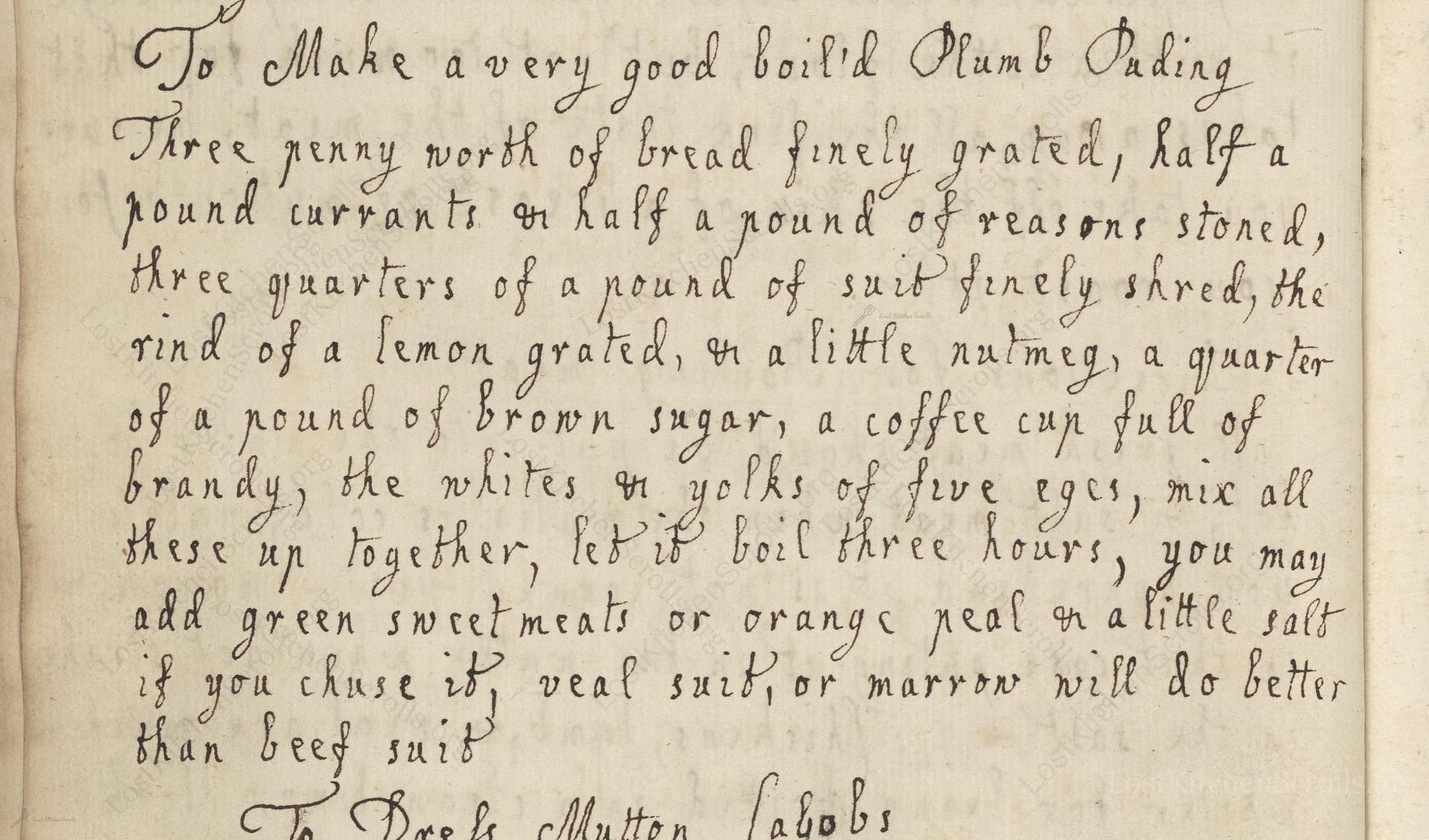To Make A Very Good Boil'D Plumb Puding
From the treasured pages of Cookbook of 1720
Unknown Author

To Make A Very Good Boil'D Plumb Puding
"Three penny worth of bread finely grated, half a pound currants or half a pound of reasons stoned, three quarters of a pound of suit finely shred, the rind of a lemon grated, or a little nutmeg, a quarter of a pound of brown sugar, a coffee cup full of brandy, the whites or yolks of five egs, mix all these up together, let it boil three hours, you may add green sweetmeats or orange peal or a little salt if you chuse it, veal suit, or marrow will do better than beef suit"
Note on the Original Text
Recipes of this era were written to experienced household cooks, using informal units like 'three penny worth' and leaving much to the cook's judgment. Measurements were approximate and based on spending or familiar household quantities, rather than standardized weights or volumes. Spelling (e.g., 'raisons' for 'raisins', 'suit' for 'suet', 'eggs' as 'egs') reflects both contemporary usage and a lack of standardized orthography. List-style instructions and brevity were standard, with the assumption that the cook understood boiling in a pudding cloth and the preparation of suet.

Title
Cookbook of 1720 (1720)
You can also click the book image above to peruse the original tome
Writer
Unknown
Era
1720
Publisher
Unknown
Background
Step back to the early 18th century and discover a delightful treasury of recipes and culinary secrets, where traditional flavors meet timeless technique—a feast for curious cooks and history lovers alike.
Kindly made available by
Folger Shakespeare Library
This recipe hails from around 1720, a period when British cookery celebrated rich, fruit-laden boiled puddings as festive and everyday fare. Plumb pudding (or plum pudding) did not necessarily contain fresh plums but referred to dried fruits such as currants or raisins, considered 'plums' in the English culinary lexicon of the time. Such puddings were a centerpiece at celebrations like Christmas, enjoyed for their luxurious combination of fruit, spirits, spices, and suet—a prized source of fat in pre-refrigeration Britain. The inclusion of brandy and candied peel hints at upper-middle-class tables, and the method reflects the absence of ovens in many 18th-century homes.

Cooks of the 18th century would have grated bread by hand using a coarse grater and chopped suet with a sharp knife. The ingredients were mixed in a large earthenware bowl. The pudding was shaped and wrapped in a well-floured linen cloth (called a pudding cloth), which was then tied securely with twine. The cloth bundle would be boiled in a heavy iron pot or cauldron suspended over the hearth, requiring constant attention to ensure the pudding did not stick or lose water during the long cooking period.
Prep Time
25 mins
Cook Time
3 hrs
Servings
8
We've done our best to adapt this historical recipe for modern kitchens, but some details may still need refinement. We warmly welcome feedback from fellow cooks and culinary historians — your insights support the entire community!
Ingredients
- 5.3oz finely grated white bread
- 8oz currants or raisins (stoned, seeds removed)
- 12oz suet (beef or veal, or marrow, finely shredded; substitute with vegetable suet if necessary)
- Zest of 1 lemon (or a pinch of grated nutmeg)
- 4oz brown sugar
- 2.7 fl oz brandy
- 5 eggs (whites or yolks, as preferred)
- Optional: 1.4oz candied green fruits (sweetmeats) or orange peel
- Pinch of salt (optional)
Instructions
- Begin by finely grating approximately 5.3 ounces of bread, preferably a dense white loaf.
- Mix in either 8 ounces of currants or 8 ounces of raisins (stoned, meaning seeded removed), and 12 ounces of beef, veal suet, or marrow (finely chopped if using suet).
- Add the grated zest of one lemon or a generous pinch of freshly grated nutmeg, depending on your preference.
- Stir in 4 ounces of brown sugar and 2.7 fluid ounces of brandy.
- Lightly beat the whites or yolks of five eggs (whites for a lighter, yolks for a richer pudding) and incorporate into the mixture.
- Optionally, fold in a small amount of candied fruits (green sweetmeats) or finely chopped candied orange peel, and a pinch of salt if desired.
- Shape the mixture into a round pudding and wrap securely in a pudding cloth, tie tightly, and submerge in a pot of boiling water.
- Boil the pudding for about three hours, ensuring the water is topped up as needed.
- Unwrap and serve warm, ideally with a sauce of your choosing.
Estimated Calories
500 per serving
Cooking Estimates
Preparation involves grating, chopping, and mixing the ingredients, which will take around 25 minutes. The pudding needs to be boiled for about three hours until fully cooked. This recipe serves about 8 people, and each serving contains roughly 500 calories.
As noted above, we have made our best effort to translate and adapt this historical recipe for modern kitchens, taking into account ingredients nowadays, cooking techniques, measurements, and so on. However, historical recipes often contain assumptions that require interpretation.
We'd love for anyone to help improve these adaptations. Community contributions are highly welcome. If you have suggestions, corrections, or cooking tips based on your experience with this recipe, please share them below.
Join the Discussion
Rate This Recipe

Den Bockfisch In Einer Fleisch Suppen Zu Kochen
This recipe hails from a German manuscript cookbook compiled in 1696, a time whe...

Die Grieß Nudlen Zumachen
This recipe comes from a rather mysterious manuscript cookbook, penned anonymous...

Ein Boudain
This recipe comes from an anonymous German-language manuscript cookbook from 169...

Ein Gesaltzen Citroni
This recipe, dating from 1696, comes from an extensive anonymous German cookbook...
Browse our complete collection of time-honored recipes



